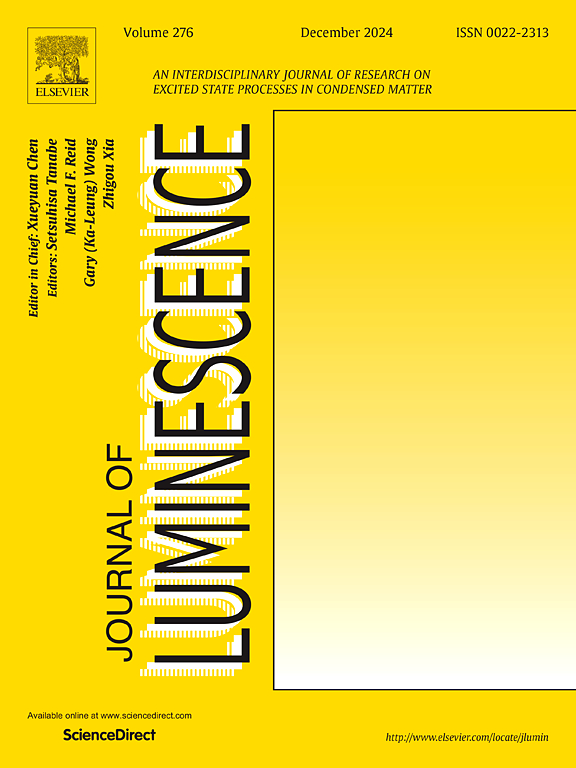Advanced interfacial engineering with Poly-TPD for CsPbBr3-based perovskite light emitting diodes
IF 3.3
3区 物理与天体物理
Q2 OPTICS
引用次数: 0
Abstract
Perovskite based light-emitting diodes are showing significant potential for next-generation displays and lighting applications as a result of easy solvent-based manufacture, high photoluminescence quantum efficiency, and tunable electronic bandgaps. Despite these advantages, morphological defects, unbalanced charge transport, and stability challenges hinder its broad applications in light-emitting devices. Herein, we introduce a simple and affordable approach to address these challenges; we fabricated the device having structure ITO/PEDOT:PSS/poly-TPD/CsPbBr3-Poly-TPD/BCP/TPBi/LiF/Al by spin coating and thermal deposition technique. To improve the morphology of the CsPbBr3 active layer, encapsulate QDs using poly-TPD for fabrication of LEDs. The interfacial chemistry of nanocrystals was tuned to obtain moderately enhanced luminescence and efficient charge transport in the perovskite layer by adjusting the concentration of the hole transport layer beneath the active layer, which is CsPbBr3 QDs mixed with the poly-TPD matrix. Full-width half maxima within 20 ± 0.5 nm after mixing with poly-TPD in the emissive layer, indicating a high degree of color purity; this type of material is well-suited for an expanded color gamut in display applications. We demonstrated a device with better surface morphology, shown by atomic force microscopy with the optimized hole transport layer concentration. The study could open the door for perovskite polymer union for better optoelectronic devices such as large-scale production of LEDs, flexible display, and stability in the air.

利用 Poly-TPD 对基于 CsPbBr3 的过氧化物发光二极管进行先进的界面工程设计
钙钛矿基发光二极管由于易于溶剂制造、高光致发光量子效率和可调谐的电子带隙,在下一代显示器和照明应用中显示出巨大的潜力。尽管有这些优点,但形貌缺陷、电荷输运不平衡以及稳定性方面的挑战阻碍了其在发光器件中的广泛应用。在此,我们将介绍一种简单且经济实惠的方法来应对这些挑战;采用自旋镀膜和热沉积技术制备了ITO/PEDOT:PSS/poly-TPD/CsPbBr3-Poly-TPD/BCP/TPBi/LiF/Al结构的器件。为了改善CsPbBr3有源层的形貌,采用poly-TPD封装量子点以制备led。通过调节活性层下的空穴传输层(CsPbBr3量子点与poly-TPD基质混合)的浓度,可以调节纳米晶体的界面化学性质,以获得钙钛矿层中适度增强的发光和有效的电荷传输。在发射层与poly-TPD混合后,全宽半最大值在20±0.5 nm范围内,表明颜色纯度高;这种类型的材料非常适合在显示应用中扩展色域。我们展示了一种具有更好表面形貌的器件,原子力显微镜显示了优化的空穴传输层浓度。这项研究可以为钙钛矿聚合物结合打开大门,用于更好的光电器件,如大规模生产led、柔性显示和在空气中的稳定性。
本文章由计算机程序翻译,如有差异,请以英文原文为准。
求助全文
约1分钟内获得全文
求助全文
来源期刊

Journal of Luminescence
物理-光学
CiteScore
6.70
自引率
13.90%
发文量
850
审稿时长
3.8 months
期刊介绍:
The purpose of the Journal of Luminescence is to provide a means of communication between scientists in different disciplines who share a common interest in the electronic excited states of molecular, ionic and covalent systems, whether crystalline, amorphous, or liquid.
We invite original papers and reviews on such subjects as: exciton and polariton dynamics, dynamics of localized excited states, energy and charge transport in ordered and disordered systems, radiative and non-radiative recombination, relaxation processes, vibronic interactions in electronic excited states, photochemistry in condensed systems, excited state resonance, double resonance, spin dynamics, selective excitation spectroscopy, hole burning, coherent processes in excited states, (e.g. coherent optical transients, photon echoes, transient gratings), multiphoton processes, optical bistability, photochromism, and new techniques for the study of excited states. This list is not intended to be exhaustive. Papers in the traditional areas of optical spectroscopy (absorption, MCD, luminescence, Raman scattering) are welcome. Papers on applications (phosphors, scintillators, electro- and cathodo-luminescence, radiography, bioimaging, solar energy, energy conversion, etc.) are also welcome if they present results of scientific, rather than only technological interest. However, papers containing purely theoretical results, not related to phenomena in the excited states, as well as papers using luminescence spectroscopy to perform routine analytical chemistry or biochemistry procedures, are outside the scope of the journal. Some exceptions will be possible at the discretion of the editors.
 求助内容:
求助内容: 应助结果提醒方式:
应助结果提醒方式:


